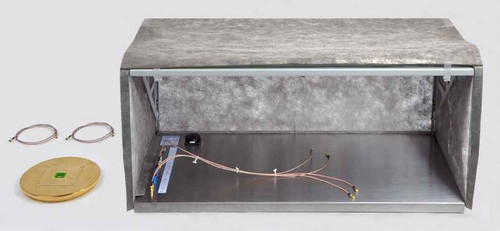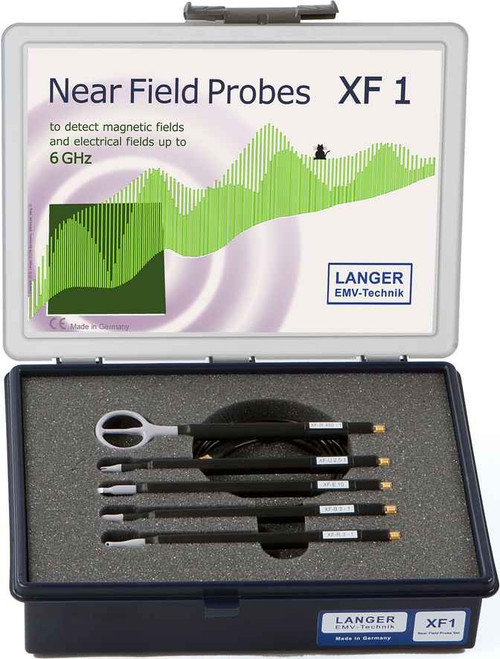Overview
The S2 set contains active and passive magnetic field probes. They measure the nonreactive fast transient pulse magnetic fields in electonic devices and assemblies under interference. Burst and ESD processes, which cause problems in the device under test, can be analyzed. The magnetic field probes transmit the measured signals via the LWL connection to the optical receiver of the SGZ 21. The S2 set can only be used with the SGZ 21 burst generator.
Scope of delivery
1x MSA 02, Magnetic Field Probe (active)
1x 05K black, Probe Head for MSA 02
1x 05R white, Probe Head for MSA 02
1x 05U orange, Probe Head for MSA 02
1x MS 101, Magnetic Field Probe
1x MS 102U, Magnetic Field Probe
1x S2 case, System Case
1x S2 m, S2 Set User Manual
Usage
For disturbance immunity problems (Burst/ESD), it was previously not possible to measure pulse current and magnetic pulse fields to assist fault identification. This was due to the extreme measuring conditions. During Burst or ESD events, measurement must be made with field strengths of 100 kV/m and pulse rise times of a few nanoseconds. Normal measuring technology, like oscilloscopes with 50 Ohm measuring leads, is not suitable for this. Extremely small and disturbance-immune probes without any electrical leads are necessary. HF and potential isolation via optical fibre is a prerequisite. With the magnetic field probes in the S2 probe set, fast transient magnetic pulse fields and pulse currents are measurable in electronic equipment and on electronic modules under extreme disturbance influence. The aim of the usage is the clarification of disturbance immunity phenomena resulting from Burst or ESD events. Targeted corrective measures can be identified from the distribution of the pulse current and magnetic pulse field measured on the module or in the equipment. The probes can only be used in conjunction with an optical fibre and optical evaluation.
Disturbance source burst generator
To make the measuring of magnetic field and current disturbance possible, these must be simulated in the unit under test.
Pulse rate procedure
The SGZ 21 burst generator contained in the E1 disturbance immunity development system makes this procedure possible. The unit under test is injected with pulses from the SGZ 21 burst generator so as to generate disturbance currents and magnetic field disturbance. The intensity of current and magnetic field can only be measured with the pulse rate procedure.
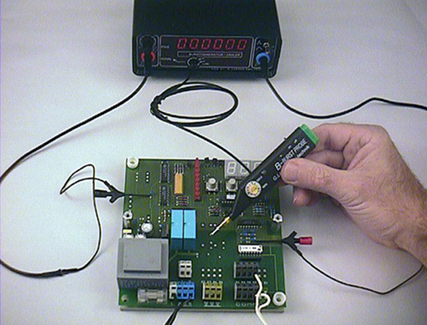
Figure 1 Pulse rate procedure with SGZ 21 burst generator and MSA 02
Threshold procedure
By using a burst generator according to EN 61000-4-4, a magnetic pulse field can be identified with a threshold value. Either the pulse rate counter of the SGZ 21 generator or the optical receiver OE 150 of the OSE optical signal acquisition, is to be used as indicating equipment.

Figure 2 Threshold procedure with MSA 02, SGZ 21 and
EFT burst generator according to EN 61000-4-4
Disturbance mechanisms
- Electronic modules have, depending on layout and IC-sensitivity, different levels of disturbance immunity.
- Precisely definable weak spots are the cause of Burst and ESD sensitivity. The formation of such weak spots depends mainly on the GND/Vcc/signal track geometry and the type/manufacturer of the IC utilized.
- Disturbance pulse current (I) infiltrates electronic modules via conductors or capacitance. Electric disturbance fields (electric field strength E) or magnetic disturbance fields (magnetic flux density B) caused by the disturbance current radiating the surface of the modules.
- Magnetic pulse fields (B) or electric pulse fields (E) are the major physical quantities which cause flat modules to be influenced.
- A weak spot is normally only magnetic sensitive or only electric-sensitive.
- In practice, both weak spot types are relevant. For example, in disturbance events, electric fields which influence electric-sensitive weak spots can occur. The currents driven by the electric field can themselves produce magnetic fields which influence magnetic sensitive weak spots (Figure 3).
- The disturbance effects of the two mechanisms overlap and are difficult to separate.
- Due to the different physical mechanisms each of the two weak-spot types requires different EMC measures.
- Usually, only a few disturbance immunity weak spots exist on one module and these are often confined to small surface areas.
- The module is immune to disturbance when these weak spots are located and corrected.
- The burst magnetic fields radiating on the module surface or within equipment spaces can be measured with special magnetic field probes without reverse reaction (S2 set).
- With the EMC sensors, reference disturbance thresholds can be modeled and influenced logical signals captured (E1, OSE 150).
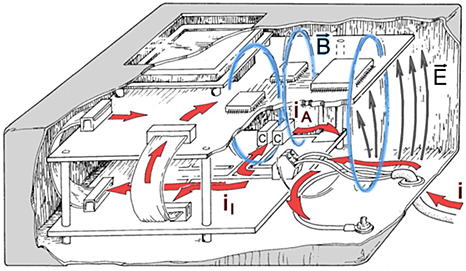
Figure 3 Field Distributions
Disturbance current (i) infiltrates the unit via the input cable. The internal disturbance current (iI) is reduced by the bypass current part (iA) leaving the unit via the bypass capacitor (C) current paths. The magnetic fields B shown in the illustration Fehler! Verweisquelle konnte nicht gefunden werden. can influence electronic modules located within some decimetres. Not all B fields infiltrating the module surface have an influencing effect. Usually, only small areas are B-field sensitive. To be observed is that magnetic fields are not only produced by disturbance current (i) in the area of feed cables and PE connections. Participating to a large extent are also bypass capacitor (C) current paths and internal GND and Vcc connections.
Electric pulse fields (E) are radiated from the leads carrying the disturbance current and these mainly influence signal connections which have a high-impedance signal source.
Functioning
Disturbance current is injected into the unit under test over the generator leads from the SGZ 21 burst generator. The resulting magnetic pulse field induces a voltage pulse in the probe’s induction coil. This is amplified and converted into an optical signal. The optical signal is fed to the optical receiver of the pulse rate counter via the optical fibre. The indicated value is proportional to the magnetic flux density and the disturbance current. The counter indicates a higher pulse rate when the magnetic field probe is placed into an area with greater field strength. The count value provides a comparison measurement for development-accompanying measurements.
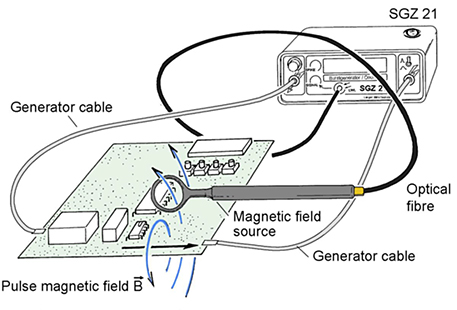
Figure 4 Pulse Rate Procedure
Disturbance current is injected into the unit under test over the generator leads from the SGZ 21 burst generator. The resulting magnetic pulse field induces a voltage pulse in the probe’s induction coil. This is amplified and converted into an optical signal. The optical signal is fed














